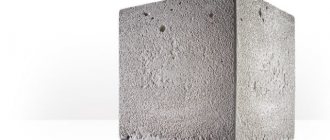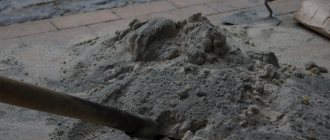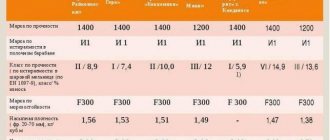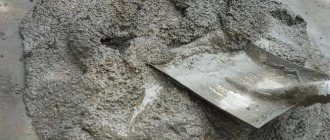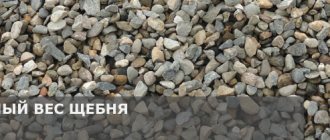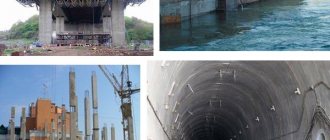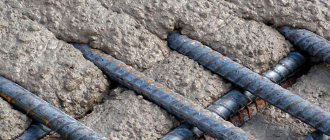Concrete is an important component both in construction and renovation. But, in order to correctly calculate the weight of structures and find out the load-bearing capacity of a building, you need to be able to calculate its weight. If you can determine how much cube concrete weighs, you can accurately determine the dimensions of the walls, the height and width of the foundation, how deep the base lies and the size of the contact area. The average 1 m3 of finished product is 2.5 tons. But the weight of the concrete mass is largely influenced by the type of mixture, the quality of the sand, reinforcement and additional components.
The presence of fittings increases the weight of the finished product by 5-10% Source golosodesa.com.ua
Dependence of weight on brand and class
Manufacturers produce cement of different brands and qualities. So for 1 m³ using the M300 and M500 brands, the difference is from 500 to 700 kg, which is directly related to the density of cement.
For this reason, concrete is divided into 4 main types: very light, light, heavy and very heavy. The heaviest versions of concrete mixtures are highly durable and are used for the construction of special structures - waste storage facilities, bunkers and other structures for similar purposes. In such cases, concrete weighing more than 3 tons is used.
Each class of concrete has its own purpose Source imagesait.ru
Lightweight options are produced in the form of blocks and are used as finishing materials, thermal insulation, or for the construction of buildings with a small number of floors.
Heavy concrete contains reinforcement and is used for pouring foundations or monolithic buildings.
Table of concrete weight in 1m3
| Cement brand | Weight in tons | Concrete class | |
| 1 | M 100 | 2, 494 | B7.5 |
| 2 | M 200 | 2, 432 | B15 |
| 3 | M 250 | 2,348 | IN 20 |
| 4 | M 300 | 2,389 | B22.5 |
| 5 | M 350 | 2,502 | B25 |
| 6 | M 400 | 2,376 | B30 |
| 7 | M 500 | 2,298 |
The weight of the finished product is affected by the quantity and quality of additional additives Source festima.ru
See also: Catalog of companies that specialize in the design and construction of turnkey country houses.
Scope of application
High-strength concrete, starting from B25, is used for prefabricated and monolithic frame elements, reinforced concrete building structures - floor slabs, columns, crossbars, trusses and crane beams. Concrete B25 (M350) and higher classes are used for the manufacture of monolithic foundations, pile-grillage reinforced concrete structures, bathtubs, and walls of swimming pool bowls. Heavy, super-strong compounds are used in road construction for the construction of bridges and tunnels. Concrete B25 (M350) is well suited for the construction of airfield runways, which must withstand long-term cyclic loads.
The use of such concrete is regulated by SNiPs and GOSTs related to work on the manufacture of reinforced concrete products. When concreting, vibration compaction must be used. To do this, when pouring prefabricated structures in a factory, stationary vibration stands or vibration platforms must be used, and when casting monolithic structures, vibrators with a flexible shaft must be used.
In addition to the widespread use of class B25 in industrial construction, it can be recommended for the construction of individual residential buildings.
It is necessary to prepare such a composition with careful adherence to the recipe. However, to prevent unforeseen and force majeure situations, it is better to order the mixture at mortar-concrete units, where incoming quality control of materials is required, as well as inspection of the resulting products. Upon delivery, the seller bears full responsibility for the quality of the solution and compliance with the characteristics.
Classification of brands depending on specific gravity
There is a concept - specific gravity of concrete. This includes the total mass of all components that may be in the composition. There are regulatory documents that specify the recipes of all brands with the percentage of additional additives.
Construction is rarely complete without the use of specialized equipment Source beton-499.ru
Particularly lightweight concrete, when 1 m³ should not exceed 1 ton. Foaming agents are added to the cement mixture. As a result, the finished product has cells filled with air. It is used to produce materials for insulating buildings or constructing outbuildings.
The light type contains additional additives: vermiculite, perlite, and other production waste with a porous structure. Its weight can be from 1 ton to 1.8 tons.
Heavy concrete is usually used for private construction or the construction of multi-story buildings. Its weight varies from 1.8 tons to 2.25 tons. The composition includes sand, gravel, and crushed stone.
Manual mixing will be cheaper, but on a large scale you need to use equipment, or buy a ready-made mixture Source ene.mn
Specific gravity of 1 m3 of concrete by grade
Weight of 1 m3 of concrete M200, M300, M400, M500
| Concrete grade | Liquid (kg) | Dry (kg) |
| M100 | 2366 | 2180 |
| M150 | 2360 | 2181 |
| M200 | 2362 | 2182 |
| M300 | 2358 | 2183 |
| M400 | 2350 | 2170 |
| M500 | 2355 | 2180 |
The mass of a cubic meter of concrete grades M100 - M500, indicated in the table, corresponds to the proportions and preparation technology in accordance with GOST 23464-79. As can be seen from the table, different grades of concrete differ in weight, but on the scale of construction, when hundreds of cubic meters of concrete are used, the difference in weight can be neglected. For ease of calculations, professional builders, engineers and private developers use a mass of 1 m3 equal to 2400 kilograms for all grades of concrete.
The weight of special types of concrete is taken from the table:
| Type of concrete, aggregate | Specific gravity of 1 m3, kg |
| Reinforced concrete | 2500 |
| Concrete on gravel or crushed stone | 2400 |
| Tufobeton | 1200-1600 |
| Pumice concrete | 800-1600 |
| Concrete on volcanic slag | 800-1600 |
| Expanded clay concrete on expanded clay sand, expanded clay foam concrete | 500-1800 |
| Expanded clay concrete on quartz sand | 800-1200 |
| Expanded clay concrete on perlite sand | 800-1000 |
| Shungizite concrete | 100-1400 |
| Perlite concrete | 600-1200 |
| Slag pumice concrete (thermosite concrete) | 1000-1800 |
| Slag pumice foam concrete and slag pumice gas concrete | 800-1600 |
| Concrete based on granulated blast furnace slag | 1200-1800 |
| Aggloporite concrete on boiler (fuel) slags | 1000-1800 |
| Concrete on ash gravel | 1000-1400 |
| Gas-ash concrete and foam-ash concrete | 800-1200 |
| Aerated concrete, foam concrete, gas silicate and foam silicate | 300-1000 |
| Vermiculite concrete | 300-800 |
What affects the cost of the mixture
Ready-mix concrete is more expensive than its components, but during continuous construction it is easier to order factory-produced concrete. The cost depends on the following factors:
- order volume - large batches of the mixture will cost less;
- filler quality;
- distance from the factory to the construction site;
- brand of cement – each type of construction has its own requirements;
- boom length - almost always requires a gasoline pump;
- on holidays and weekends the mixture will cost more.
The finished mixture can be purchased in any volume Source cipasera.com
Briefly about the main thing
The strength of concrete does not depend on weight, but on the quality of the main components, as well as their percentage. Concrete with a high level of density is resistant to low temperatures, moisture and mechanical damage. It is the main material for road slabs or building foundations because it can withstand heavy loads.
| A little more attention! Write in the comments what you think - with only theoretical knowledge about the strength of materials, is it worth building a house? |
Methodology for measuring the strength of concrete
Methods for determining the strength characteristics of a material and requirements for control samples are established by GOST 10180-2012. To calculate the strength of concrete, it is necessary to measure the minimum force that can destroy a certain sample. In this case, the static load should increase at a constant speed.
The type of control samples depends on the method used to determine the strength characteristics.
Methods for determining the strength characteristics of concrete
Also, to determine the characteristics, other types of samples can be used: cubes with ribs measuring 7 cm, prisms with dimensions of 7 x 7 x 28 cm, cylinders with a diameter of 7 cm. The dimensions of the control samples are interrelated with the size of the filler used in the mixture.
The dimensions of the control samples are interrelated with the size of the filler used in the mixture
Samples of concrete (mixture), from which control samples are made, are taken from the working composition of the concrete mixture. The solution is poured into calibrated molds, previously treated with lubricant on the inside. It should not change the characteristics of the surface layer of the control product. The mixture is compacted by bayoneting, using a vibrating platform or an internal vibrator.
Vibrating platform
Sample hardening modes vary depending on the technology used in production. If natural hardening is used, after production the samples are stored at a temperature of 20±5 degrees in molds covered with material to prevent moisture evaporation. Formworking of products is carried out after 24...72 hours (when studying compressive strength) or after 72...96 hours (when determining tensile strength). Then the samples continue to harden at a temperature of 20±2 degrees and a humidity of 95±5%.
Testing of concrete samples
Control samples, which are expected to harden under the influence of heat, are placed (in molds) in special units: an autoclave, a steaming chamber, etc. After processing, the samples are released from the formwork and stored under normal conditions or sent for testing.
Testing
To determine the compressive strength, samples are placed between the slabs and a constantly increasing load of 0.6 ± 0.2 MPa/s is applied to them (until failure).
Compression test
Testing of samples for tensile bending is carried out in testing machines using an increasing load of 0.05±0.01 MPa/s.
Concrete resists compression well and poorly in tension
The splitting tensile test is determined on the plate of a testing machine. The test is carried out at a constant rate of load increase (0.05±0.01) MPa/s.
Samples of different types of concreteThe axial tensile test is carried out using a gripping system at a constant rate of load increase (0.05±0.01) MPa/s until the sample fails. After the experiments, the strength of the samples is calculated. All data is recorded in the test log.
Sample test report
Tests are carried out for each batch of products or structures.
